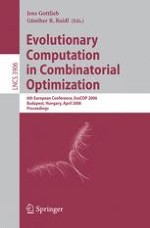2006 | Buch
Evolutionary Computation in Combinatorial Optimization
6th European Conference, EvoCOP 2006, Budapest, Hungary, April 10-12, 2006. Proceedings
herausgegeben von: Jens Gottlieb, Günther R. Raidl
Verlag: Springer Berlin Heidelberg
Buchreihe : Lecture Notes in Computer Science
